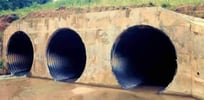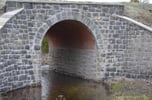If you think about it, CULVERTS are a bit of an anomaly in the structural world. Culverts carry various load types (pedestrian, vehicular, and cattle), cross a body of water, and follow the AASHTO LRFD specifications similarly to bridges. However, culverts are not considered "bridges" as per the FHWA classification because they usually do not exceed 20 feet.
Still, bridges and culverts share common functionalities, so besides length, what else determines a bridge and culvert? By definition, a culvert is a drainage structure that passes under a roadway, akin to a tunnel. Like bridges, there are a few different types of culverts:
 |
 |
 |
 |
 |
| Pipe (single or multiple) | Pipe-Arch (single or multiple) | Concrete Box (single or multiple) | Arch | Metal Box |
Small culverts generally are constructed with a standard pipe, and larger culverts with box sections, either cast-in-place or precast. Although similar, each culvert consists of slightly different components. We start our list here.
1) Structure Components - The components of a bridge largely breakdown into three parts: superstructure, substructure, and foundation.

Superstructure - Deck and Girders
Substructure - Abutments, Pier, Pile Cap
Foundation - Pile
The components of a culvert are simpler than that of a bridge. They consist of the pipes or boxes, a top and bottom slab, and the support walls, like WING WALLS
2) Support - Since the pipes and boxes only go as far as the bottom of the stream, culverts do not require deep foundations. SPREAD FOOTING or pile footing provides sufficient stability. It's also essential to note that culverts are buried structures. Meaning there is no distinction between the superstructure and substructure. Instead, they carry vertical loads through a combination of internal capacity and soil arching. So, culverts rely on the surrounding soil for support and stability, otherwise known as SOIL-STRUCTURE INTERACTION.
Bridges tend to be self-supporting. What this means is that the substructure is an integral part of the bridge. It's because of the loads from the substructure transfer to the foundation and surrounding soil. Therefore, bridges must have a stable and deep foundation along the span length.
3) Design - Any load-carrying structure requires compliance to the AASHTO LRFD standard regardless of bridge or culvert. The main difference with the design are not the standards but rather who checks the compliance. With bridges, because most are cast-in-place structures, the design engineers are the ones who validate the factors.
With precast culverts and some cast-in-place culverts, often, the design is offset to the manufacturers are the ones who fabricate the sections. This is because the manufacturers cast the section per ASTM Specification C1577, AASHTO LRFD Specifications, and the Bridge Manual.
4) Construction - There are two types of concrete construction, cast-in-place, and precast. As the name suggests, cast-in-place indicates that the concrete is poured on-site while precast means it was prefabricated offsite. Recently, there have been significant improvements and push for Accelerated Bridge Construction (ABC), which allows for prefabricated sections of the bridge to be installed over a few days. However, this method is still far and few between for bridge construction.
On the other hand, culverts can go either way, every time. Cast-in-place culverts are customize-able for in-situ scenarios but take longer. Precast culverts have been more expensive than cast-in-place culverts in the past but allow for reduced construction time. Whether it's a cast-in-place or precast culvert, it's not a complex structure that would take an inordinate amount of time.
5) Cost - This may be no brainer, but bridges tend to cost more than culverts. The time directly correlates to the total cost of the project. Bridges require more strict design criteria, which means more time spent by consultants, more material, extended construction, which ultimately adds up in project cost.
Culverts are simpler structures and designs, which require less time and labor. However, maintenance is the real consideration here. Inspectors handle both bridge and culvert inspection. As a result, key issues are sometimes overlooked due to more familiarity with bridge inspections. These could fall into disrepair or reduce the functionality of the culvert, which would end up doubling the efforts. Not to mention, culverts need cleaning periodically as they can clog from debris.
Culverts are a widespread structure found throughout North America. However, the design of new culverts is not as frequent as beam bridges. Because of this, even with bridges being more complicated, there are far more references engineers can rely on. Therefore, engineers who find themselves with a moderately complex, longer span box culvert bridge look for more technical documents and design guides for reference, to be sure. This concludes our list of 5 differences between culverts and bridges.
The post 5 Differences Between Culverts and Bridges appeared first on Civil Engineering Community.
source https://www.civilax.com/5-differences-between-culverts-and-bridges/


